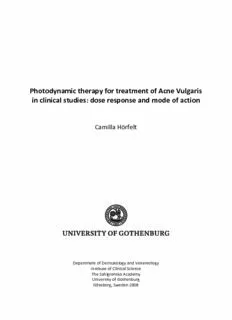
Photodynamic therapy for treatment of Acne Vulgaris in clinical studies PDF
Preview Photodynamic therapy for treatment of Acne Vulgaris in clinical studies
Title: Photodynamic therapy for treatment of Acne Vulgaris in clinical studies: dose response and mode of action Author: Camilla Hörfelt ISBN 978-91-628-7579-4 E-mail: [email protected] Department of Dermatology and Venereology, Sahlgrenska University Hospital, Institute of Clinical Science at Sahlgrenska Academy, University of Gothenburg, Göteborg, Sweden 2009 Cover: The cover picture illustrates a patient with Acne Vulgaris undergoing photodynamic therapy. The digital version can be downloaded from http://hdl.handle.net/2077/19061 Print: Geson Hylte Tryck, Göteborg, Sweden 2009 To my family – Hans, Emma and Carl If we continue to do what we have always done, we will continue to get what we have always got. Words from an unknown philosopher Photodynamic therapy for treatment of Acne Vulgaris in clinical studies: dose response and mode of action Camilla Hörfelt Department of Dermatology and Venereology, Institute of Clinical Sciences at Sahlgrenska Academy, University of Gothenburg, Göteborg, Sweden. Abstract This thesis deals with the use of photodynamic therapy (PDT) for treatment of Acne Vulgaris. Acne Vulgaris is one of the most common skin disorders. Conventional treatments target the pathogenic factors and include a variety of topical and oral medications such as antibiotics. Many patients show no clinical response or experience side effects from these conventional therapies. The wide use of antibiotics leads to bacterial resistance, and hence there is a need for new alternatives in acne treatment. Photodynamic therapy (PDT) is based on an initial photosensitization of the skin, followed by irradiation with visible light producing cytotoxic singlet oxygen. When PDT is applied for treatment of acne it is believed to affect the sebaceous gland and the bacterium P.acnes; however, the full mechanism involved in PDT of acne is not clear. The work in this thesis deals with investigating mechanisms of action and the most effective treatment regimen for PDT of acne. Patients with mild to severe acne have been studied. In a nonblinded dose finding study, patients received aminolaevulinic acid (ALA) PDT at different light doses on the cheeks and on the back. No significant difference in clinical result was found between the different light doses of ALA-PDT, although pain and hyperpigmentation were more common at higher doses. In a split-face placebo- controlled blinded study, patients received two consecutive methylaminolaevulinate (MAL) PDT and placebo treatment. Greater reduction in total inflammatory lesion count was obtained with two consecutive MAL PDTs compared with placebo PDT; however, in another split-face un-blinded controlled study, where single-treatment low light dose MAL-PDT and treatment with red light only were compared, no significant difference between the treatment protocols was obtained. Both MAL- PDT and red light only showed significant decrease in acne score. The studies also showed that there was no significant reduction of P. acnes or sebum excretion, neither for ALA-PDT nor for MAL-PDT. Furthermore, fluorescence images revealed poor selectivity of MAL-induced fluorescence to the acne lesions. In a fourth, in vitro study the photodynamic effect on the skin bacteria P.acnes was investigated. Bacteria suspensions were anaerobically incubated in the presence or absence of sensitizer, i.e. ALA or MAL. The viable counts of P.acnes were significantly reduced after illumination with either red or blue light when incubated in the presence of either ALA or MAL; however, long incubation times were necessary (4 to 5 days), confirmed by fluorescence measurements. Taken together, the results of this thesis suggest that PDT using either ALA or MAL is effective in treatment of acne. Light doses minimizing side effects such as pain and hyperpigmentation should be applied. However, the results also imply that explanations other than eradication of P. acnes and destruction of the pilosebaceous unit should be considered for describing the mechanisms behind the treatment. Key words: Acne Vulgaris, delta-aminolaevulinic acid, fluorescence imaging, methyl-aminolaevulinic acid, photodynamic therapy, porphyrins, Propionibacterium acnes ISBN 978-91-628-7579-4 Göteborg 2009 PUBLICATIONS This thesis is based on the following papers, which are referred to in the text by their Roman numerals: I. C. Hörfelt, J. Funk, M. Frohm-Nilsson, D. Wiegleb Edström and A-M Wennberg. Topical methyl aminolaevulinate photodynamic therapy for treatment of facial acne vulgaris: results of a randomized, controlled study, Br J Dermatol 2006; 155: 608-13 II. C. Hörfelt, B. Stenquist, O. Larkö, J. Faergemann and A-M Wennberg. Photodynamic Therapy for Acne Vulgaris: a Pilot Study of the Dose-Response and Mechanism of Action, Acta Derm Venereol 2007; 87: 325-329 III. C. Hörfelt, B. Stenquist, C. B. Halldin, M.B. Ericson, A-M. Wennberg. Single low dose red light is as efficacious as MAL-PDT for treatment of acne: Clinical assessment and fluorescence monitoring. Submitted for publication. IV. C. Hörfelt, N. Karami, J. Faergemann, A-M. Wennberg, M.B. Ericson.Photodynamic effect in Propionibacterium acnes: An in vitro study investigating the effect of red and blue light in the presence and absence of aminolaevulinic acid or its methyl ester. Submitted for publication. CONTENTS LIST OF ABBREVIATIONS .................................................................................................... 1 INTRODUCTION ................................................................................................................. 2 Acne Vulgaris ............................................................................................................................ 2 Propionibacterium acnes (P.acnes) ............................................................................................ 7 Treatment of Acne Vulgaris ....................................................................................................... 8 Antibiotic resistance in P. Acnes _____________________________________________ 9 Photodynamic Therapy (PDT) .................................................................................................. 10 Basic aspects ___________________________________________________________ 10 Photosensitization ______________________________________________________ 10 Photosensitization using ALA ______________________________________________ 11 Photophysics ___________________________________________________________ 12 Light sources for PDT ____________________________________________________ 14 Adverse events of PDT ___________________________________________________ 14 Photoactivation of bacteria ..................................................................................................... 15 Photoactivation of P.acnes ________________________________________________ 15 Light therapy and Acne Vulgaris ............................................................................................... 15 Topical PDT and Acne Vulgaris _____________________________________________ 16 Adverse events of PDT and Acne Vulgaris ____________________________________ 17 Fluorescence Diagnostics ......................................................................................................... 17 Fluorescence of Acne Vulgaris _____________________________________________ 18 AIMS OF THE INVESTIGATION .......................................................................................... 20 PATIENTS ........................................................................................................................ 21 Ethics ...................................................................................................................................... 22 METHODS ....................................................................................................................... 23 Statistical Methods.................................................................................................................. 26 RESULTS .......................................................................................................................... 27 DISCUSSION .................................................................................................................... 32 Methodological considerations ................................................................................................ 32 GENERAL DISCUSSION ..................................................................................................... 35 CONCLUSIONS ................................................................................................................. 38 OUTLOOK FOR THE FUTURE ............................................................................................. 39 ACKNOWLEDGEMENTS .................................................................................................... 41 REFERENCES .................................................................................................................... 43
Description: